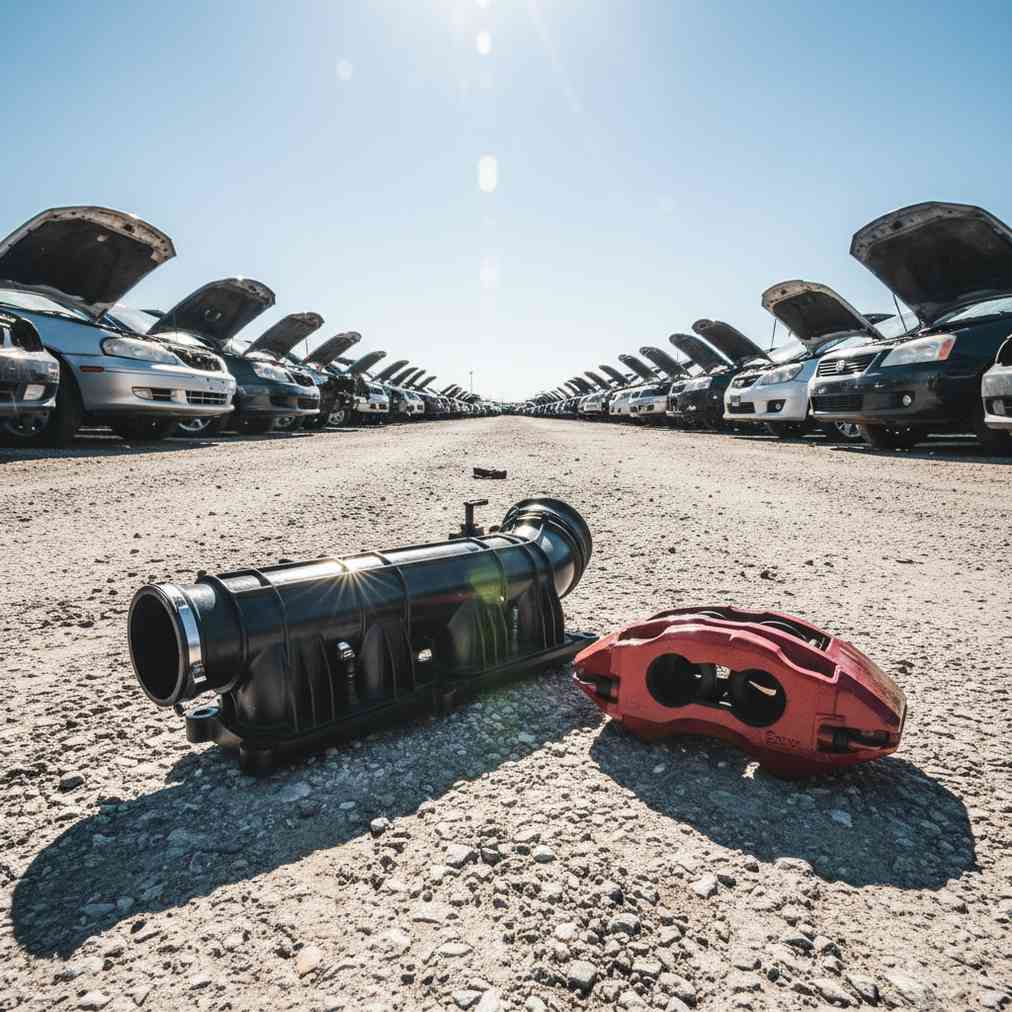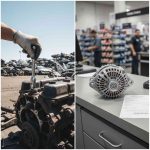The Self-Service Model: What Sets Pull-A-Part Apart
Pull-A-Part operates on a self-service salvage yard model where customers take complete responsibility for finding, removing, and extracting the auto parts they need. Unlike traditional auto parts stores with staff assistance, Pull-A-Part requires visitors to bring their own tools and rely on their mechanical knowledge to navigate the yard successfully.
This unique approach significantly reduces operational costs, which translates into substantial savings for customers. The trade-off is clear: lower prices in exchange for customer labor and strict adherence to company policies.
What Customers Love About Pull-A-Part
Massive Inventory and Fresh Selection
One of the most praised aspects of Pull-A-Part is their impressive inventory size. Most locations maintain approximately 2,000+ vehicles on their lots, with new arrivals added daily to ensure a constantly refreshing selection. This vast inventory gives customers a much higher chance of finding the specific parts they need.
The company has invested in a state-of-the-art online inventory database that’s refreshed daily, allowing customers to search for vehicle availability before making the trip. They also offer a helpful “Notify Me” feature where customers can register to receive alerts when a desired vehicle model arrives on the lot.
Significant Cost Savings
The financial benefits of shopping at Pull-A-Part are substantial. Their standardized pricing structure, where parts are priced by category rather than individual assessment, offers remarkable savings compared to new parts:
| Part Type | Pull-A-Part Price Range | New Part Price Range | Potential Savings |
|---|---|---|---|
| 4-Cylinder Engine | $150 – $300 | $2,500 – $4,000 | 85% – 92% |
| Transmission | $200 – $500 | $2,000 – $3,500 | 75% – 90% |
| Admission Fee | $2.00 – $3.00 | N/A | Low entry cost |
These savings make Pull-A-Part an attractive option for budget-conscious car owners, DIY mechanics, and automotive enthusiasts looking to find affordable parts at junkyards near me.
Perfect Training Ground for Automotive Enthusiasts
Many customers appreciate Pull-A-Part as an ideal environment for practicing automotive repairs and learning about vehicle systems. The self-service nature allows enthusiasts to:
- Practice disassembly techniques in a real-world setting
- Learn about different vehicle systems and layouts
- Work underneath vehicles that are properly elevated
- Gain hands-on experience without the pressure of working on their own car
This educational aspect has made Pull-A-Part popular with automotive students, hobbyists, and anyone looking to develop their mechanical skills.
Warranty Protection
Despite being a self-service operation, Pull-A-Part provides a 30-day warranty on most parts, offering customers either exchange options or store credit if a part fails. This warranty provides peace of mind that’s often missing from other salvage yard experiences.
Common Customer Complaints and Concerns
Strict No-Negotiation Pricing Policy
The most frequently mentioned criticism of Pull-A-Part is their inflexible pricing structure. Customer feedback consistently highlights that Pull-A-Part maintains strict, non-negotiable prices across all parts and services. Many customers describe them as an “opportunistic car-parts company” that doesn’t negotiate on anything, regardless of the part’s condition or customer loyalty.
“Pull-A-Part is not a car dealership – they’re an opportunistic car-parts company that doesn’t negotiate on anything.”
Customer Review
Self-Reliance Requirements and Minimal Staff Assistance
The self-service model demands significant preparation and mechanical knowledge from customers. Key challenges include:
- Tool Requirements: Customers must bring their complete toolset, and toolboxes are inspected upon entry
- Limited Staff Help: Minimal assistance from yard personnel means success depends entirely on customer knowledge and effort
- Safety Responsibility: Customers work without professional supervision, creating inherent safety risks
Time Investment and Uncertainty
Searching for and removing parts can be extremely time-consuming, especially for newcomers or when dealing with hard-to-reach parts. A major frustration point is that while the online inventory shows which vehicles are present, it doesn’t indicate which specific parts have already been removed by other customers, leading to potentially wasted trips and hours of searching.
The research indicates that successful visits often require several hours of work, and customers must be prepared for the possibility that their desired part may have already been claimed by another customer.
Physical Demands and Weather Exposure
The outdoor nature of salvage yard work means customers must perform physical labor regardless of weather conditions. This includes:
- Working in extreme temperatures, rain, or snow
- Handling heavy parts without assistance
- Crawling under vehicles and into tight spaces
- Standing and walking for extended periods on uneven terrain
Quality Assessment Challenges
Unlike purchasing new parts with guarantees, Pull-A-Part customers must rely entirely on their own judgment to assess part quality and functionality. There’s no guarantee regarding the final condition of retrieved parts, which can lead to disappointment if a part fails after installation.
Recent Technology Improvements
Pull-A-Part has made significant investments in technology to improve the customer experience. Recent developments include:
- Advanced Online Inventory: State-of-the-art database refreshed daily
- Vehicle Notification System: Alert system for desired vehicle arrivals
- Weekend Inventory Policy: No new vehicles added on Saturdays and Sundays, ensuring Monday searches show the previous week’s complete inventory
These technological improvements address some customer concerns about inventory uncertainty, though the fundamental self-service model remains unchanged. For those looking to get an instant quote for their junk car, Pull-A-Part also operates as a vehicle purchaser in addition to parts sales.
Expert Analysis of the Pull-A-Part Model
Industry experts note that the trend toward self-service junkyards continues to grow as they offer eco-friendly alternatives by recycling parts and reducing automotive waste. However, as one expert observes:
“Success requires mechanical knowledge and willingness to invest time. The self-service model isn’t for everyone, but it can provide significant savings for those prepared to do the work.”
Industry Expert
The model works best for customers who view the experience as part hobby, part necessity, rather than those seeking quick, convenient solutions. This aligns with broader trends in data analysis and consumer behavior research that show successful self-service models require customer engagement and education.
Tips for Maximizing Your Pull-A-Part Experience
Based on extensive customer feedback, here are strategies for success at Pull-A-Part:
Preparation Strategies
- Research First: Use the online inventory system and notification features
- Bring Complete Tools: Pack more tools than you think you’ll need
- Check Weather: Plan visits for favorable weather conditions when possible
- Allow Sufficient Time: Budget several hours for each visit
In-Yard Success Tips
- Start Early: Arrive when the yard opens for the best selection
- Inspect Thoroughly: Test parts when possible before removal
- Bring Help: Consider bringing a knowledgeable friend for assistance
- Document Everything: Take photos of part locations and removal processes
The Environmental Impact Factor
Many customers appreciate Pull-A-Part’s contribution to environmental sustainability. By recycling automotive parts and keeping vehicles out of landfills, the company plays a significant role in the circular economy. This environmental benefit resonates strongly with eco-conscious consumers who view their purchases as contributing to sustainable practices.
The environmental angle has become increasingly important as more consumers seek ways to reduce their carbon footprint while maintaining their vehicles affordably.
Final Customer Verdict
The Pull-A-Part experience divides customers into clear camps: those who embrace the challenge and those who find it frustrating. Success largely depends on customer expectations, mechanical knowledge, and willingness to invest time and effort.
Pull-A-Part works well for:
- DIY mechanics and automotive enthusiasts
- Budget-conscious consumers willing to work for savings
- People who enjoy the treasure hunt aspect
- Those seeking to learn about automotive systems
- Environmentally conscious consumers
Pull-A-Part may not suit:
- Customers seeking quick, convenient solutions
- Those without mechanical knowledge or proper tools
- People with physical limitations or time constraints
- Customers who prefer negotiable pricing
- Those requiring guaranteed part functionality
Understanding these dynamics helps potential customers set appropriate expectations and determine whether the Pull-A-Part model aligns with their needs, skills, and patience levels. The company’s strict policies and self-service requirements aren’t likely to change, so customer satisfaction ultimately depends on embracing the model rather than fighting against it.
As the automotive industry continues evolving toward more specialized and expensive parts, companies like Pull-A-Part provide valuable alternatives for cost-conscious consumers willing to invest their time and effort in exchange for significant savings.





Leave a Reply
You must be logged in to post a comment.